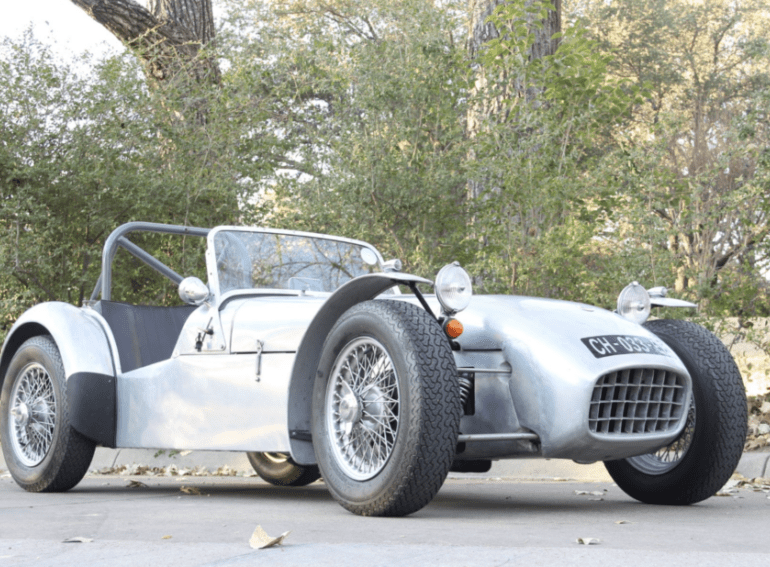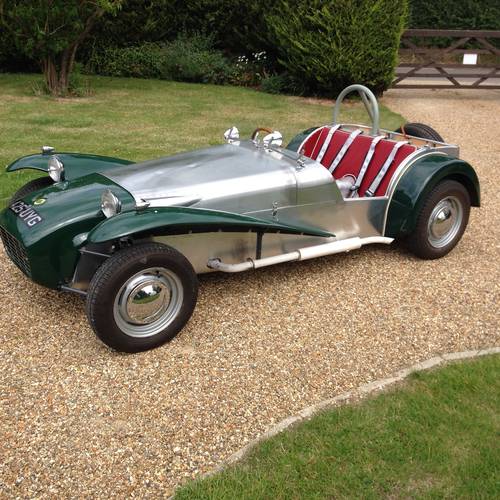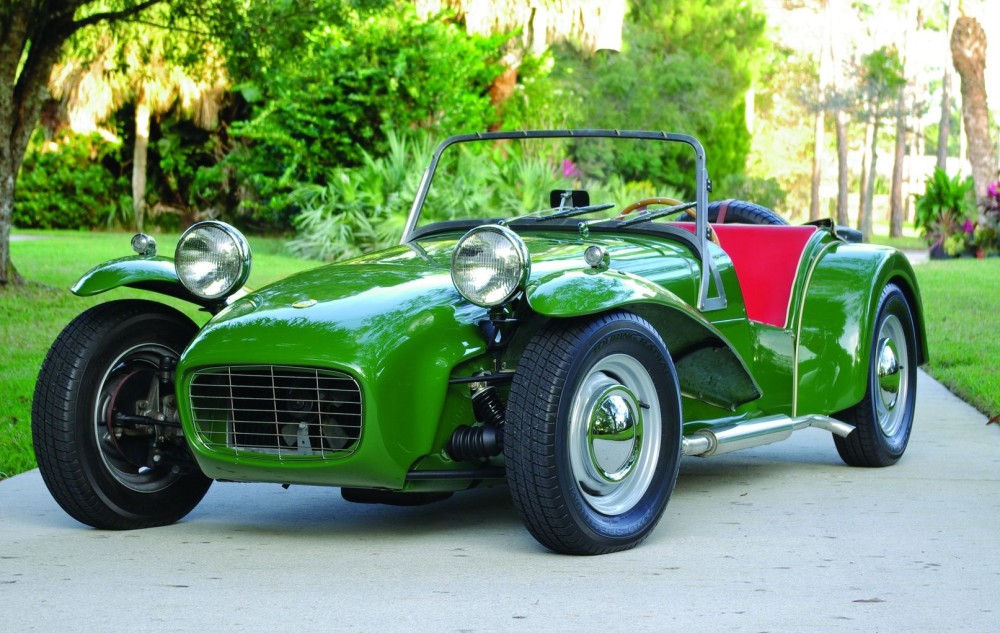1957-1960 Lotus 7
“Adding lightness” is how Colin Chapman described his minimalist engineering philosophy. Of all the cars he made with this ethos, none have become more prolific than the Seven (7). It’s one of the most copied designs and many companies have made their own version.
Launched in 1957 at the Earls Court Motor Show, the 7 was a simple and lightweight sports car that sold as a kit for the British market. It made no concessions to passenger comfort, instead focusing on performance and low cost though the use of readily available parts. This helped the car succeed and become an icon of British performance.
Engineering for the 7 came from the Lotus 6 roadster which used a steel space frame and stressed aluminum panels to support a Ford engine. Its driver was pushed back, almost behind the rear axle, to make room for the engine. The 7 was similarly built and initially came with a Ford 100E side-valve engine that could produce 40 bhp in its highest state of tune.
The chassis itself was produced at Progress Chassis Company and was a multi-tube space frame that used stressed aluminum panels. These panels encased the entire car, including the bottom of the engine and rear differential. Since the design had fairly high sides, the entire structure was inherently rigid.
Since the chassis was limited to flat aluminum panels, the shape of the body was also simple. Williams and Pritchard cycle fenders which were included, but they caused considerable lift and drag at high speeds. All the panels were sold unpainted leaving the customer to either paint or polish the exterior.
Related: Lotus Race Car List / Lotus Current Lineup / All Lotus Models / Lotus News
Much of the suspension and components were outsourced from mass-produced British cars. The front double wishbone setup incorporated Standard vertical links. Rear axles came from the Nash Metropolitan and were supported by trailing arms. Several different steering types were used including rack & pinion systems from Morris and Triumph.
Sold as a kit, the 7 became a hit with do-it-yourself fans. Furthermore, it avoided purchase tax laws as long as assembly instructions were not included. To subvert the law, Lotus included ‘Disassembly Instructions’. Built at home, most 7s varied in specification and performance. Some cars used Mark XI running gear which was never a factory option.
If built to standard specification, the 7 had a hard time reaching 90 mph. Many race-spec examples easily exceeded this figure, but it’s not straight-line performance where the 7 excelled. Instead, the car’s low weight, low center of gravity and exceptional rigidity helped it perform.
The very first 7 was completed in July of 1957 at the Hornsey, London factory. Factory pre-production prototypes with Ford engines were built in October later that year. Once production commenced, first Ford version sold for £551. In 1958, this was followed by the Super 7 which was fitted with a Coventry Climax engine and sold for £892.
The 7 motivated a series race in Britain with the 750 Motor Club. Eight, Ten, Popular, Anglia or Prefect engines were permitted from 933cc to 1172cc. The one-model race was intended for an “amateur constructor-tuner with limited resources.”
By 1960, the series two (S2) debuted. This was followed by less successful variants until design rights were eventually sold to Caterham in January, 1973.
Pictures
Specs & Performance
| type | Racing Car |
| production years | 1957 – 1960 |
| built at | London, England |
| production | 240 |
| price $ | $ £526 |
| engine | Ford 100E Inline-4 |
| position | Front Longitudinal |
| aspiration | Natural |
| valvetrain | Side Valves, 2 Per Cyl |
| fuel feed | Single Downdraught Solex or Twin SU H2 Carburetors |
| displacement | 948 cc / 57.9 in³ |
| bore | 63.5 mm / 2.5 in |
| stroke | 92.5 mm / 3.64 in |
| compression | 7.0:1 |
| power | 29.8 kw / 40.0 bhp @ 5000 rpm |
| specific output | 42.19 bhp per litre |
| bhp/weight | 121.58 bhp per tonne |
| torque | 78.64 nm / 58 ft lbs @ 2600 rpm |
| body / frame | Stressed Aluminum Panels over Progress Steel Spaceframe |
| driven wheels | Front Engine / RWD |
| wheel type | Steel Wheels |
| front tires | 520 x 15 |
| rear tires | 520 x 15 |
| front brakes | Girling Drums |
| f brake size | 38.1 x 203 mm / 1.5 x 8 in |
| rear brakes | Girling Drums |
| r brake size | 38.1 x 203 mm / 1.5 x 8 in |
| front wheels | F 38.10 x 10.16 cm / 15 x 4 in |
| rear wheels | R 38.10 x 10.16 cm / 15 x 4 in |
| steering | Worm & Nut or Morris Rack & Pinion |
| f suspension | Lower Wishbones w/Upper Links, Anti-Roll Bar, Coil Springs, Armstrong Telescopic Dampers |
| r suspension | BMC Live Axle w/Trailing Links, Anti-Roll Bar, Coil Springs, Armstrong Telescopic Dampers |
| curb weight | 329 kg / 725 lbs |
| wheelbase | 2235 mm / 88.0 in |
| front track | 1232 mm / 48.5 in |
| rear track | 1232 mm / 48.5 in |
| length | 3353 mm / 132.0 in |
| width | 1481 mm / 58.3 in |
| height | 1092 mm / 43.0 in |
| transmission | 3-Speed Manual |
| gear ratios | 3.664:1, 2.007:1, 1.000:1 |
| final drive | 4.875:1 |
| top speed | ~136.8 kph / 85.0 mph |
| 0 – 60 mph | ~14.3 seconds |
| 0 – 1/4 mile | ~19.2 seconds |









